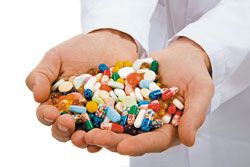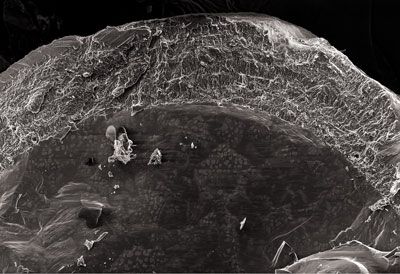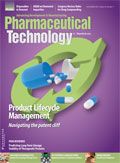Solvent-Free Coating of Traditional and User-Friendly Dosage Forms
The benefits of solvent-free processes and techniques specifically optimized for coating new dosage forms such as orally disintegrating granules are reviewed.

Tablets and capsules are often coated for various reasons such as to improve their appearance or to make them easier to swallow. Coatings also play an important role in maintaining drug stability, activity, and effectiveness. This article reviews the benefits of solvent-free processes and techniques specifically optimized for coating new dosage forms such as orally disintegrating granules (ODGs).
Coating technologies and methods
Coating is usually achieved with one of a variety of techniques but regardless of the equipment and coating process used, there are several common challenges and considerations that will influence coating success. Firstly, the coating should be immediately stable (e.g., without the need for a curing step), reproducible, and cost efficient. Secondly, the coating process used during formulation development must be easy to transfer to manufacturing conditions and ready for scale-up, using excipients that can be easily and safely stored in bulk amounts.
In terms of the coating itself, some approaches can lead to structural polymorphism within the coating, which can render it difficult to consistently predict drug-release profiles, bioavailability, and efficacy while also affecting intellectual property (IP) protection and infringement. Such variations can arise during the coating process or develop over prolonged storage; hence, it is important to select a method where these factors have been studied and are well understood.
Liquid coating using solvents
Liquid coating is a reliable and well-established technology that is still the industry standard for coating many APIs but it has several disadvantages. Firstly, liquid coatings must be dried to form a solid final product, a time-consuming process that often requires an increase in temperature that incurs additional cost. The use of heat may also cause thermal stress, leading to API degradation. When using liquid coating, it may also be necessary to spray the tablet core or seed particle with several layers to create the final dosage form or intermediate with the desired characteristics. This step adds time and complexity to the procedure and can have detrimental effects on the quality of the final product by causing variability in the crystalline form or an uneven, heterogeneous coating, thereby, leading to unwanted polymorphism or defects. Besides affecting stability, performance, and efficacy, such structural variations can also have important IP implications. For example, it may be that certain polymorphic forms of the API are protected by patents, and thus, must be avoided. For these reasons, solvent-free coating technologies are of interest.
Solvent-free coating
Solvent-free coating offers several advantages over the use of solvents by reducing the time and costs associated with drying liquid coatings. It can also reduce the thermal stress imposed on the API and simplify the coating process by reducing the number of steps required to reach the final product. These methods include compression coating, electrostatic spray powder coating, supercritical fluid coating, photocuring, and hot-melt coating (HMC).
Compression coating
Generally, when coating tablets, the APIs are initially granulated before being blended with further excipients, compressed into tablets, and finally coated. It is also possible to use these uncoated tablet cores in a second compression step designed to surround them with an additional layer containing certain functional excipients, such as a second API or an additional dose of the same API. The method is well suited for producing multi-stage treatments that combine two or more APIs, particularly if they are incompatible and must be physically separated within the dosage form, or if their mode of action requires that they are administered to different parts of the digestive system.
Perhaps the biggest drawback of compression coating is that in the second compression step, it can be difficult to position the tablet core accurately in the center of the tablet, which is important for reproducible formulation and reliable pharmaceutical performance. Various efforts have been made to circumvent this problem, leading to the development of new approaches such as the one-step dry-coated (OSDrC) tablet manufacturing system, which can reduce the likelihood that the compaction process will negatively affect tablet performance (1). The excipients must also be carefully selected. Using appropriate fillers and/or binders is essential to successfully creating a solid dosage form by compression. Finally, because many APIs and excipients are simply not compressible in their crystalline or amorphous forms, an alternative solvent-free coating methodology must be selected.
Electrostatic spray powder coating
An advantage of spraying liquid coatings onto tablet cores is that the final product is visually appealing, creating a clean, polished, and homogenous coating. To pseudo-replicate the process but without the need for solvents, researchers have developed ways to replace liquids with dry powders. One such approach, electrostatic spray powder coating, uses powdered raw materials that have been electrostatically charged through the application of high voltage. These materials are sprayed onto a neutrally charged seed pellet and will adhere to the surface by electrostatic forces. The coating is then fixed in place by temperature or exposure to infrared radiation for approximately 1 to 2 minutes (2, 3). The main advantage of the process is that the coating forms and hardens quickly while the final product can easily be customized in terms of properties and thickness by adjusting the composition and amount of mixture sprayed on the
tablet core prior to fixation.
For the process to work, however, the coating and tablet core must possess certain conductive properties, or be modified using additional steps to introduce electric charge. To circumvent this issue, the conductivity of the core particle can by increased by wetting it with water to decrease resistance, although this method introduces moisture into the tablet and can lead to instability. Another way to improve conductivity is to modify the surface of the API substrate using polar groups. This method is usually achieved by dissolving the polar groups in a volatile solvent before spraying the solution onto the tablet core, thereby, reintroducing a solvent step into the process. Either way, the electrostatic attraction between the solid substances tends to be weak, hence, making it difficult to produce a thick coat without multiple rounds of spraying and fixing. The fixing step also requires moderate heating, hence, increasing the energy required to carry out the method, which potentially leads to API instability. Current research is focused on finding new ways to increase the conductivity of the tablet core and lower the glass transition temperature of the coating polymer (4).
Photocuring
A fundamental stage in the coating process is the fixation of the coating to form a solid, protective layer. In many cases, this step involves the use of heat. This increase in temperature requires costly energy and many APIs become more susceptible to degradation as temperature increases. Photocuring attempts to avoid these problems by employing a method of fixation dependent on light energy rather than heat. As such, it does not require any heating or drying steps and is ideal for temperature-sensitive APIs. The process hinges on the use of light energy to trigger a polymerization reaction to convert a liquid or granulate surface coating into a solid material. The technique has been successfully used in pharmaceutical coating to create immediate and sustained-release dosage forms (5).
While coating can proceed rapidly, oxygen in the ambient atmosphere can slow or halt the reaction and in some cases, must be purged from the formulation or manufacturing system using nitrogen, which adds complexity and cost to the process. While this technique has clear applications for heat-sensitive compounds, it is unsuitable for excipients or APIs that are photosensitive. Moreover, the process is expensive and is still in early phase development.
Supercritical coating
One way to avoid the downsides of traditional liquid coating is to use supercritical liquids, which have properties between liquids and gases along a continuum that can be manipulated. Like liquids, they can be used to dissolve the excipients and API, thereby facilitating the mixing and formation of a homogeneous coating. Carbon dioxide is most widely used because of its low critical temperature (31 °C) and pressure (74 bar), making it easy to manipulate under manufacturing conditions. The major benefit compared with standard liquid coating is that supercritical liquids can be rapidly transitioned to the gaseous phase by a reduction in vessel pressure, causing the excipient mixture to precipitate and form a solid. Unlike solvent-based methods, the technique leaves no residue and does not require any heating or drying steps.
Supercritical liquid coating has so far proven to be effective for coating of fine particles. The supercritical liquid solvating power can be controlled by small changes in temperature or pressure, thereby, enabling the fine-tuning of coating properties (6). However, for the process to work effectively, the core particle onto which the coating forms must be insoluble in the supercritical fluid. In addition, high-pressure equipment is required to carry out the process, which adds further cost to an already expensive approach.
Hot-melt technology for coating ODGs
Despite the various methods available for coating traditional dosage forms that improve taste, mouth-feel, and ease of swallowing, many patients still complain that swallowing tablets and capsules is painful and unpleasant. According to a large pan-European study, more than 25% of a particular general practitioner’s patients complained of swallowing difficulties (7).
Orally disintegrating granules (ODGs) are user-friendly dosage forms designed to meet patients’ needs, improve adherence, and increase treatment effectiveness. ODGs provide value for patients as they rapidly dissolve in the mouth, thereby circumventing any issues with swallowing. They can also be quickly and easily administered without the need for water and are much simpler to administer to children and the elderly. As they are not constrained by physical size, ODGs can also be formulated to contain larger amounts of API and/or multiple APIs in a single dose, simplifying treatment regimens.
The effective coating of APIs for ODGs is dependent on many factors. Solvent-based coating is applicable for ODGs, but suffers from heating, drying, and potential stability complications while most organic solvents inherently pose various health and environmental risks. Although several solvent-free approaches have been used with some success for coating ODGs, especially electrostatic spray powder coating, most of them are time-consuming and expensive, often leading to a final product that does not adequately mask the bitter taste of most APIs. In addition, many approaches are not practical for coating large numbers of small granules. For example, compression coating is better suited for coating larger tablets. While new approaches such as supercritical liquid coating and photocuring may offer an effective way to coat ODGs, both methods are still experimental, expensive, and impractical for scale-up.
In an effort to avoid the use of solvents and identify coating methods that might be suitable for ODGs, there has recently been significant research and development into novel methods of pharmaceutical coating. One such technology, hot-melt coating (HMC), is gaining popularity as it offers short processing times (typically under 1 h) and significantly lowers costs compared to other solvent-free methods. HMC avoids the use of solvents by instead utilizing molten mixtures, which are sprayed onto solid particles usually using a fluid bed coating setup. This mixture then solidifies upon cooling to form a protective coating around the seed particle containing the API. The excipients most suitable for HMC include lipids, waxes, fatty bases, and hydrogenated vegetable oils, as they are easy and quick to process, cost-effective, and have relatively low melting points (below 100 °C).

Compared to other solvent-free coating methods, HMC is particularly well suited for taste masking and careful manipulation of API release (8), making it ideal for formulating ODGs. By carefully selecting excipients based on molecular flexibility, hydrophobicity, melting point, molecular weight, and rigidity, as well as optimizing their relative concentrations, it is not only possible to fine-tune the release profile of the API to provide sustained or delayed release but also to provide immediate release products (see Figure 1) (9, 10).
Although HMC can be carried out using a variety of methods and common manufacturing equipment including fluidized bed and spray coating, optimization of the protocol for each API/excipient mixture takes skill, knowledge, and experience. Air-flow, spray rate as well as spray and product temperature must be carefully controlled during the process to enable to successful melting and solidification of the excipient mixture to create a pleasant tasting, homogenous coating with the desired API release characteristics. These parameters are important and when the process is carried out correctly, dosage forms coated using HMC do not suffer from some of the polymorphic variations (and associated challenges) that other coating methods may exhibit.

It is important to create formulation and manufacturing processes that embody quality-by-design (QbD) principles to enable a seamless transition during scale-up, and at the same time employ process analytical technology (PAT) that measure HMC parameters, such as coating thickness, to enable their accurate correlation with final product characteristics. Offline methods, such as scanning electron microscopy, can also be used to assess product quality, because they enable the surface and coating layer of ODGs to be visualized (see Figure 2).
Optimizing HMC
While HMC is a suitable API-coating method for producing ODGs with delayed- or sustained-release profiles, optimizing the process for producing rapid-release medications such as analgesics has proven to be a challenge. A team at Hermes Pharma is collaborating with the Research Center Pharmaceutical Engineering GmbH (RCPE), INNOJET Herbert Hüttlin, CREMER Oleo GmbH & Co. KG, and the Karl Franzens University to identify and develop HMC parameters for producing such fast-acting medicines. The goal of the project is to develop new pharmaceutical formulations and manufacturing processes, and engineer new approaches and manufacturing controls for effective masking of the unpleasant tastes and smells associated with most APIs.
Preliminary results from the ongoing project have highlighted that the production of fast-release medicines using HMC is feasible and amenable to scale-up. The transfer of the technology into production is underway. In several proof-of-principle studies, the parameters for formulating ODGs containing fast-acting APIs were successfully identified. The proof of concept studies included many different lipids, such as mono-, di- and triacylglycerides with varying carbon chain length (C14 to C22). In addition, more than 10 emulsifiers were tested. The resulting dosage forms provide rapid dissolution characteristics, similar to those of film-coated immediate-release tablets. Importantly, the granules are pleasant tasting and easy for patients to ingest. The HMC approach at Hermes is being extended to formulate other fast acting medicines such as ODGs, with the method expected to be fully validated and available for use by pharmaceutical developers in the near future.
References
1. Y. Ozeki, Y. Watanabe, H. Okamoto, and K. Danjo, Pharm. Res. 21 (7) 1177-1183 (2004).
2. S. Bose and R.H. Bogner, Pharm. Dev. Tech. 12, 115-131 (2007).
3. M. Qiao et al., Eur. J Pharm. Biopharm. 83, 293-300 (2013).
4. M. Qiao et al., Eur. J Pharm. Biopharm. 76 (2) 304-10 (2010).
5. S. Bose and R.H. Bogner, AAPS Pharm. Sci. Tech. 8 (3) E57 (2007).
6. Y. Wang, R. N. Dave, and R. Pfeffer, J Supercritical Fluids 28, 85-99 (2004).
7. O. Andersen et al., Tidsskr Nor Laegeforen. 115 (8) 947-9499 (1995).
8. S.G. Sudke and D.M. Sakarakar, J Pharm. Res. Clin. Prac. 3 (1) 16-26 (2013).
9. J.P. Kennedy and P.J. Niebergall, Pharm. Dev. Technol. 3 (1) 95-101 (1998).
10. V. Jannin et al., Int. J Pharm. 262 (1-2) 39-45 (2003).
About the Authors
Detlev Haack, PhD, is director of R&D, and Martin Koeberle, PhD, is senior manager, analytical development, both at Hermes Pharma, Georg-Kalb-Strasse 5-8, 82049 Pullach, Germany.

Drug Solutions Podcast: A Closer Look at mRNA in Oncology and Vaccines
April 30th 2024In this episode fo the Drug Solutions Podcast, etherna’s vice-president of Technology and Innovation, Stefaan De Koker, discusses the merits and challenges of using mRNA as the foundation for therapeutics in oncology as well as for vaccines.
Drug Solutions Podcast: Applying Appropriate Analytics to Drug Development
March 26th 2024In this episode of the Drug Solutions Podcast, Jan Bekker, Vice President of Business Development, Commercial and Technical Operations at BioCina, discusses the latest analytical tools and their applications in the drug development market.
INTERPHEX 2025: Use of Walk-In Chambers for Bio/Pharma Development and Manufacturing
April 2nd 2025Sitting down with the PharmTech Group at INTERPHEX 2025, Christopher Murphy, director of Global Business Development and Service Customer Support at Environmental Specialties, discusses the design and critical role of walk-in chambers in the bio/pharmaceutical industry.